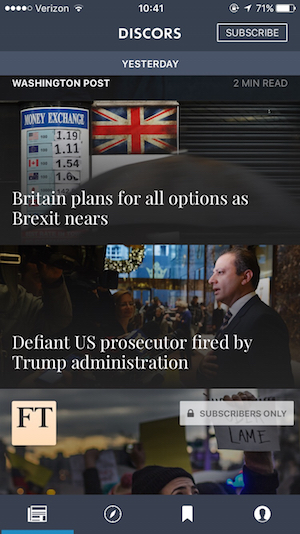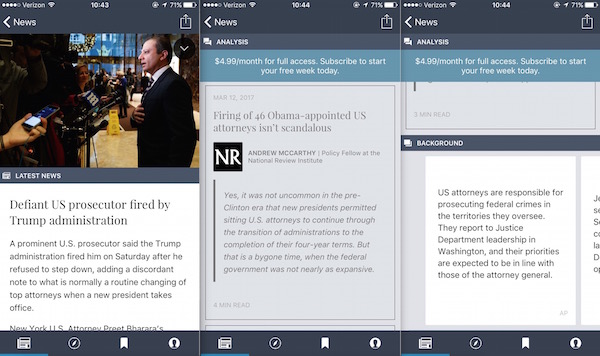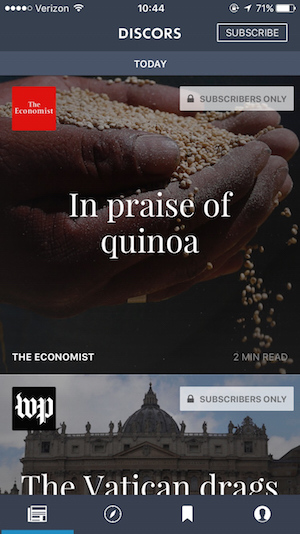
But the company quickly realized that the concept wasn’t going to work. “It was going to be very difficult to get people to pay for that,” CEO and cofounder Basil Enan told me.
 So, in true startup fashion, it pivoted. This month, the company launched a revamped version of its app that moved away from highlighting individual contributors and instead lets users access commentary and analysis from publishers such as The New York Times, The Financial Times, The Washington Post, and The Economist for a monthly price.
So, in true startup fashion, it pivoted. This month, the company launched a revamped version of its app that moved away from highlighting individual contributors and instead lets users access commentary and analysis from publishers such as The New York Times, The Financial Times, The Washington Post, and The Economist for a monthly price.
A subscription to the app costs $4.99 per month.
The main screen of the Discors app lists stories by topic — such as Britain’s preparations for Brexit or the firing of U.S. Attorney Preet Bharara. Discors subscribes to wire services such as the Associated Press and Reuters, and each topic starts with a wire story and then it lists pieces that offer different viewpoints on that story.

The new version of the app also features individual stories from participating publishers in the main stream in order to give them more prominence.
 Discors pays “tens of thousands of dollars every month” to all its publishers in order to access a set number of stories per month. Enan said the app’s editorial team tries to curate at least two stories per day from participating outlets.
Discors pays “tens of thousands of dollars every month” to all its publishers in order to access a set number of stories per month. Enan said the app’s editorial team tries to curate at least two stories per day from participating outlets.
Enan’s pitch to publishers is that Discors provides a middle-tiered subscription product to appeal to readers who might not want to pay for a full subscription.
“The big question became: Why would the publishers do this? Are they going to play ball?” he said. “We spent the better part of the past two years making that case to them — and certainly we’re not the only ones beating that drum — to say there’s another way to do this, and that starts with accepting there are a lot of people out there when presented with that binary choice — $400 a year for the FT or $0 a year for no FT — the vast majority of people, myself included, say I can’t do that. I’m not going to get enough value out of the FT right now to subscribe, so I don’t subscribe.”
(The standard rate for a Financial Times digital subscription is $332, or $533 for a “premium digital” subscription.)
Discors initially charged 99 cents per month, but it realized that it was “probably too low to make it sustainable,” so the app raised the subscription price to $4.99. So far, Enan said Discors has “a couple hundred” subscribers, and he made a point to emphasize that they had not begun to promote the app in earnest.
Still, there have been multiple attempts, by both publishers and third-party aggregators, to try and capture a middle tier of subscribers — something below an all-access subscription but above zero.
The New York Times in 2014, for instance, launched standalone apps such as NYT Now and NYT Opinion that offered lower-priced access to certain areas of the Times’ coverage. The paper ultimately shut down NYT Opinion and made NYT Now free — before eliminating it last year — due to lack of interest from potential subscribers.There’s Scroll, Tony Haile’s upcoming startup, which featured big-name publishing investors (Axel Springer, News Corp, The New York Times) and a subscription model built around better presentation of selected content from a variety of publishers.
There are a handful of apps, such as Texture and Zinio — along with Amazon Prime — that let users pay a monthly fee to access a number of different magazines. Then there’s Blendle, the Dutch micropayment startup that allows its users to buy stories from a variety fo publishers by the article. The company launched in the United States last year with publishers such as the Times, which is an investor in the company, The Washington Post, and more.Enan said Discors wanted to stay away from the micropayment model in order to give users a more nuanced experience. “They need to get behind the paywall, but they want someone to do a little bit of work on their behalf, curating pieces from each of these publications, bringing together lots of publications but selecting pieces from each of those so it’s not overwhelming,” he said.
Earlier this year, however, Blendle launched Blendle Premium in the Netherlands, a €9.99 ($10.66 USD) per month service that lets users read 20 stories per day that are selected for users based on their interests.
For its part, Discors is targeting additional publishers; Enan said The Atlantic, The New Yorker, and The Wall Street Journal top its list. The company raised $1.2 million last year, and also went through the Matter incubator program.
Ultimately, Enan said Discors would like to potentially integrate with platforms such as Facebook or Apple News that would provide it access to a larger user base. But for now, the app’s top priority is to gain users and also to add more publishers. The app is still “not even close” to breaking even, but Enan said the company first had to spend money to get publishers on the platform.
“Really, it’s solving that chicken and the egg problem: You need the publishers first before people are willing to sign up,” he said. “And this is why we’re starting to get out there more broadly now.”